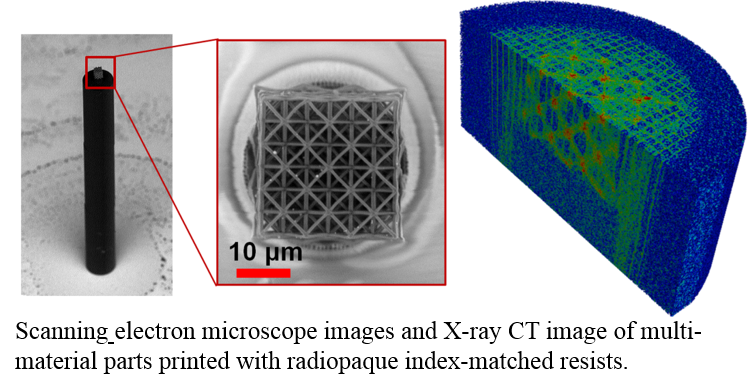3D printing of parts utilizes light to cross link and solidify ( i.e photopolymerize) a liquid plastic that is used to build up the part. Recent developments in photo-polymerization based additive manufacturing (AM) have opened up the design space for fabrication of arbitrarily complex 3D structures by enabling precise localized control of geometry and materials. Unfortunately, one is unable to fully exploit the capabilities of AM due to the lack of metrology tools for non-destructive inspection and verification of internal features. As a result, it is not possible to verify whether a fabricated AM part meets the design tolerances, thereby severely limiting AM adoption in fabrication of functional parts. X-ray computed tomography (CT) is a promising technique for AM metrology that is capable of imaging internal features. However, polymer parts poorly attenuate X-rays and appear transparent due to the low atomic number of the constituent elements. What is needed is a radio-opaque photopolymer so that 3D X-ray computed tomography can be used to non-destructively inspect the internal dimensions of the part.
LLNL has developed an optically clear iodine-doped resist that increases the mean atomic number of the part. AM parts fabricated with this resist appear radio-opaque due to an increase in the X-ray attenuation by a factor of 10 to 20 times. Optical clarity is required so that the photons can penetrate the liquid to initiate polymerization and radio opacity is required to enable 3D computed tomographic imaging for final inspection via X-rays. The refractive index of these resists is matched to that of the immersion medium of oil-immersion objective lenses. As a result, these resists may also be used with high numerical aperture immersion objectives during dip-in two-photon lithography – a submicron additive manufacturing technique for printing tall millimeter-scale structures.
Dimensional inspection of finished product is required in all manufacturing. This can be done by either a part by part inspection or through statistical validation of the manufacturing process. In either case there is no process or part certification without inspection. Being able to inspect the interior features of a 3D part is required for 3D printing process improvement and validation.
LLNL has leveraged the optical clarity of its resist formulation to enable printing with submicron resolution via the two-photon polymerization process. In addition, our resist formulation ensures that (i) iodine is homogenously distributed even at the level of submicron features and (ii) the concentration of iodine in the fabricated part is insensitive to the variations in the polymerization and/or post-curing process steps. Thus, our resist can successfully replace existing photopolymers and can generate AM parts that are suitable for inspection via X-ray CT. This inspection capability is essential in transitioning polymer AM technologies from the state of research curiosities to well-characterized systems capable of fabricating functional parts to tight design tolerances. By providing the "feedstock" for radio-opaque AM parts, the LLNL resist formulation is expected to play a dominant role in the future development, growth, and adoption of polymer additive manufacturing technologies.
- Raw material (resist) for two-photon polymerization additive manufacturing (with submicron building blocks)
- Raw material (resist) for all polymerization based additive manufacturing
- Fabrication of high-energy laser targets with high-Z materials, high-contrast polymer parts for calibration of X-ray CT systems
- Radio-opaque polymer AM parts for photonic crystals (sensors), mechanical metamaterials (low-density, high-strength engineered metamaterials), and microfluidics (for biomedical diagnostic chips).
LLNL has solved the challenges of creating an optically clear radio-opaque photopolymer resist for AM by mixing in an optically clear organoiodine compound to a resist blend optimized for localized curing so that it acts as both a prepolymer and a contrast agent. As a result, during additive manufacturing the organoiodine compound gets chemically bonded with the other prepolymer/monomer components of the resin to form cross-linked polymer chains at the scale of the submicron and micron building blocks that comprise the final polymerized part. Thus, the iodine atoms are homogenously distributed throughout the part and cannot be physically "washed out" during post-processing development. Such a radio-opaque part can be imaged via X-ray CT to inspect the internal features of the additively manufactured part.
LLNL is using its innovative optically clear iodine-doped resist to fabricate calibration samples for nano-CT X-ray imaging system.
LLNL has filed a patent application for this technology (U.S. 15/367069); LLNL internal case number (IL-13103).
This technology has also been published in a peer-reviewed journal article. The article was featured on the cover of the journal for the Jan 10, 2018 issue.


